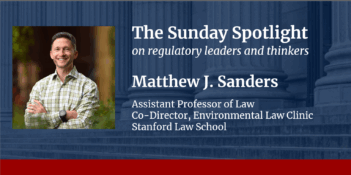
Black Louisiana residents have been disproportionately burdened by hazardous industrial air pollutants.
In a region of Louisiana colloquially known as Cancer Alley, some people are almost 50 times more likely than the average American to develop cancer. Now there is strong evidence that state regulators allowed those cancer risks to fall disproportionately on the Black residents of the area, according to the U.S. Environmental Protection Agency (EPA).
In a letter to two Louisiana agencies, EPA describes its fact-finding results from an investigation into a potentially discriminatory air pollution permitting program in the state. The preliminary conclusion appears damning: EPA found “significant evidence” that Louisiana regulators’ “actions or inactions have resulted and continue to result in disparate adverse impacts on Black residents” in Cancer Alley.
The plant at issue in EPA’s investigation, Denka, emits an air toxin known as chloroprene. EPA classified chloroprene as a likely human carcinogen over a decade ago. In addition to an increased likelihood in developing cancer, long-term exposure to chloroprene can cause problems with the brain, lungs, heart, stomach, skin, and eyes. And as EPA notes, many residents in the Industrial Corridor in Louisiana live in the same area from childhood to adulthood, increasing their susceptibility to those exposure risks.
Two complaints filed in 2022 allege that the Louisiana Department of Environmental Quality (LDEQ) and the Louisiana Department of Health (LDH) have caused Black residents to suffer disproportionately from those negative health impacts of chloroprene.
That racial disparity, according to the complainants, violates Title VI of the Civil Rights Act. Under Title VI, any programs—such as LDEQ and LDH—that receive assistance from the federal government may not discriminate on the basis of race.
Based on its letter, it appears that EPA, at least initially, agrees with the complainants.
In the letter, EPA expresses concern with LDEQ’s air permitting program. According to EPA’s investigation, LDEQ downplayed residents’ concerns about the carcinogenic emissions as mere “fear mongering” and misrepresented EPA’s findings as to the dangers of chloroprene. EPA also notes LDEQ’s lacking procedures for citizens to express grievances as well as its failure to act on three Denka permits that expired over two years ago.
In addition, EPA found evidence that LDH relied on outdated and inaccurate data and consistently failed to communicate relevant information about hazardous air pollutants to the exposed communities.
These agencies’ actions and inactions have resulted in quantifiable harms for Black residents, according to EPA’s initial findings. In St. John the Baptist Parish, where the controversial Denka facility operates, an elementary school sits roughly 1,500 feet from Denka’s doorstep. The parish is 58 percent Black—though Louisiana is only 33.5 percent Black—and its residents face a lifetime cancer risk that is four times the acceptable upper bound of estimated excess cancer risk.
EPA notes that these cancer risks “clearly fall ‘substantially disproportionately’ on the Black residents” of Cancer Alley as compared with white residents.
EPA recommends that LDEQ and LDH perform additional monitoring and data collection in St. John the Baptist Parish. EPA also advises LDEQ to determine more suitable locations that could “temporarily host” the parish’s elementary school.
These recommendations, however, do not yet have any binding effect on the state. EPA resolved with LDEQ and LDH to proceed by an informal resolution agreement, so all parties must negotiate and agree to a path forward before any of them take any concrete action.
In response to the letter, spokespersons for LDEQ and LDH highlighted the agencies’ willingness to cooperate with the process. LDEQ, though, maintained its confidence that “we are implementing our air permitting program in a manner that is fully consistent with” the law.
Throughout EPA’s investigation, Jim Harris, a spokesperson for Denka, has denied the seriousness of the plant’s emissions, claiming that “there is simply no evidence of increased levels of health impacts.” At the same time, Harris touted Denka’s investments of “over $35 million to reduce chloroprene emissions by 85 percent” since 2015.
Advocates for the residents of the Industrial Corridor appear to feel tentatively triumphant. The founder of Concerned Citizens of St. John, Robert Taylor, has been quoted as saying that EPA is finally “considering our humanity.”
Taylor, though, reportedly still remembers how “my community has been failed time and time again by every level of government.”
Cancer Alley’s history of environmental racism is long, with roots dating back to the Reconstruction Era. When slavery ended, plantation properties in Louisiana were mostly returned to white landowners, and newly freed Black people purchased the small strips of adjacent land where slave quarters used to be. Industrial plants were then built on top of the old plantations. As a result, as one reporter has put it, the “map of southern Louisiana’s petrochemical and petroleum plants” nearly matches “archival maps of the area’s plantations.”
Although EPA’s letter is a powerful statement, the parties involved still have a long process ahead. As the negotiations move forward, it remains to be seen what, if any, relief EPA will provide for Cancer Alley residents.



